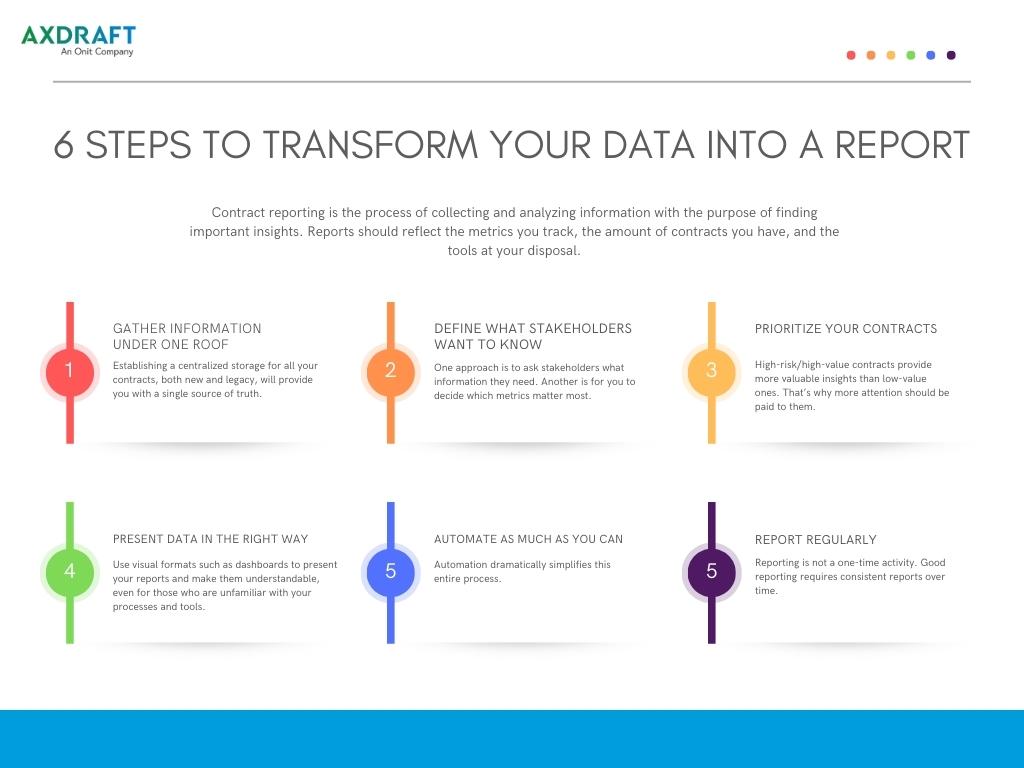Got no time to read? Listen to our blog on the go
What if you always knew which decision would get the desired result? You’d never make a mistake at running a business. You’d always be successful. And you’d never face an issue.
This is what we call a utopia.
Unfortunately, utopias don’t exist. But depending on how you use your company’s data, you can still enable data-driven decisions that will help you reach your business goals.
To better understand how data works, there are 4 levels of data maturity:
- Descriptive data: “What happened?”
- Diagnostic data: “Why did it happen?”
- Predictive data: “What will happen?”
- Prescriptive data: “How can we make it happen?”
Even though there may not be a clear answer to the question “How can I get what I want?”, we can still leverage data to make reasonable predictions for potential results and their causing factors.
That’s why collecting and analyzing contract data is a critical task. It provides information and insights about possible workflow improvements, risks, strategies, and actions to take.
For instance, converting data into a growth report is just one way to support business strategies, tactics, and goals.

Data is Gold
Managed correctly, data is an invaluable asset. The list of decisions you can make based on contract information can stretch from here to the moon (and beyond).
Since we don’t want to waste so much paper, here are a few of the most common actions that contract data can enable:
- Assess company performance and evaluate the efficiency of company processes, determine the location of bottlenecks, and forecast profitability.
- Evaluate geographical performance to get a better view of which regions are the most or least profitable (or problematic), as well as the customer profile for a specific region and ways to improve performance in certain areas.
- Spot problem areas and patterns that can be driven by specific contract conditions (e.g. local legislation, services, etc.)
- Decide how to manage contracts better, which contracts should be prioritized, and how it will impact processes.
- Identify how to improve contract lifecycle management, find weak points, unearth bottlenecks, and determine possible ways to eliminate them.
- Use historical data about the performance of similar contracts and decide if a contract is worth negotiating.
- Decide which partnerships are good for your business and which should be given up.
- Assess risks such as supply chain disruptions, broken obligations, or others to decide whether those risks outweigh the benefits of working with a vendor.
- Determine when you need to increase or decrease prices and accurately forecast the impact on your market share and bottom line.
- Decide when is the best time to offer additional products or services to existing customers, as well as renegotiate, renew, or terminate contracts.
Effectively using contract data can lead to better decisions and reduced risks, as well as financial savings and profitable customer and partner relationships. It also provides you with the ability to adjust your strategy to fit market requirements, which can eventually open up new opportunities and increase revenues.
But for this to happen, data needs to be analyzed. The best way to do this is by building it into a report.
Reporting
Contract reporting is the process of collecting and analyzing information with the purpose of finding important insights. Reports should reflect the metrics you track, the amount of contracts you have, and the tools at your disposal.
Here are some steps that will help you transform your data into a report.

- Gather information under one roof
Establishing a centralized storage for all your contracts, both new and legacy, will provide you with a single source of truth. Plus, by keeping it in one system, it’s easier to organize all the contracts and information submitted by different departments.
Without a central storage, you’ll have to track contracts across different systems and folders. This makes it more difficult since you may end up spending more time hunting down information than you did analyzing it. In addition, if data differs, you can’t know which source is wrong. Ultimately, you may not even be able to create the report.
- Define what stakeholders want to know
A growth report is what helps determine what your company should focus on and where to improve. It’s also used for fine-tuning a growth strategy. But considering that contracts are full of data, it’s essential to carefully select the data you want to track and use for generating insights.
One approach is to ask stakeholders what information they need. Another is for you to decide which metrics matter most. For legal, this may be the average approval time. For sales, it might be annual contract value. And for the financial department, they may prefer the economic value generated by certain agreements.
Be sure to choose the right KPIs for the right teams so that they can use them to adjust their strategies.
- Prioritize your contracts
Most likely, your company deals with various types of contracts that all carry differing levels of risks and values. Typically, high-risk/high-value contracts provide more valuable insights than low-value ones. That’s why more attention should be paid to them.
Additionally, it’ll be easier to stay focused on essential KPIs like conversion rates, annual contract value, customer acquisition cost, and others.
- Present data in the right way
Use visual formats such as dashboards to present your reports and make them understandable, even for those who are unfamiliar with your processes and tools.
Specialized software can prove helpful in this regard. For example, some CLM solutions permit the custom configuration of reports so that you can analyze your contracts, team, and business performance.
With custom reporting capabilities, you can choose which information you’d like to add to reports and create dashboards according to the information selected. This enables you to evaluate the performance of a particular group of contracts or of each contract separately.
- Automate as much as you can
Collecting and analyzing information manually can be tedious.
Here’s what a manual approach can look like:
- You read the entire document and outline all important details like the contract’s value, duration, etc.
- You spend a lot of time and energy organizing the data and entering it into a spreadsheet. You also double-check to make sure nothing was entered incorrectly (spreadsheets are infamous for costly typos – just ask Kodak and Barclays).
- Analyze the data collected. Filter and compare information, identify trends, and calculate revenue and losses. Double-check once more.
- Present the data in the form of an analysis. Format it into charts, graphs, or other visual forms to make it more understandable.
Automation dramatically simplifies this entire process. But for automation to run well, it needs fuel, and the fuel for automation is data about data, or what we call metadata.
All contracts receive metadata when they’re created or uploaded to a platform. Metadata makes it possible to track certain information, which in turn helps create reports. With metadata, you only need to choose the metrics you want to report and the system will build the report for you.
Advanced CLM solutions allow you to customize metadata. This can be file size, type, quality of data, contract amount, or whatever else you need. The end result is that searches become simpler and data is more structured.
For example, if you use different time ranges as tags, you can create reports about active, expiring, and already expired contracts. Or you can combine time frames with other tags and get reports about all customer contracts with an end date within the next 90 days.
- Report regularly
It’s important to review contracts and extract data from them regularly.
Reporting is not a one-time activity. Good reporting requires consistent reports over time.
However, the reward is worth the effort. You’ll be able to track changes and see if outcomes meet your expectations or if you need to make certain adjustments to achieve your goals.
Here are a few advantages of regular reporting:
- Gives a clear overview of your position. This depends on what you’re tracking, such as financial results, how the company fulfills its obligations, turnaround time, etc.
- Tracks your progress. Regular reports allow you to refine your strategy and decide what additional steps you need or don’t need to take.
- Drives better decisions. Accurate, timely, and relevant information helps you make smarter data-driven decisions.
- Creates a paper trail. Historical records are especially useful when you want to analyze successful (or unsuccessful) strategies. It will help you identify decisions that can drive a certain outcome.
If the capabilities of the CLM you use allow it, you can schedule and receive reports in accordance with a set schedule.
Successful implementation of growth strategies is reliant on regular reports that affirm decisions and provide guidance. Consequently, you’ll know where your organization stands, its strong and weak points, and if changes should be made.
Wrapping Up
Growth reports are essential if you want to keep a close eye on your company’s performance over time and adapt your strategy to changing market conditions.
Having a good tool that collects data quickly, transforms it into reports, and presents them to your executives makes reporting much easier (and life much simpler). AXDRAFT CLM helps you keep all information at your fingertips while giving you the flexibility to add custom metadata and simplify information tracking. Custom dashboards and reports further help you in your work by allowing you to present information in a convenient and understandable way.
Book a demo with our team to see how AXDRAFT can help you leverage data effectively.